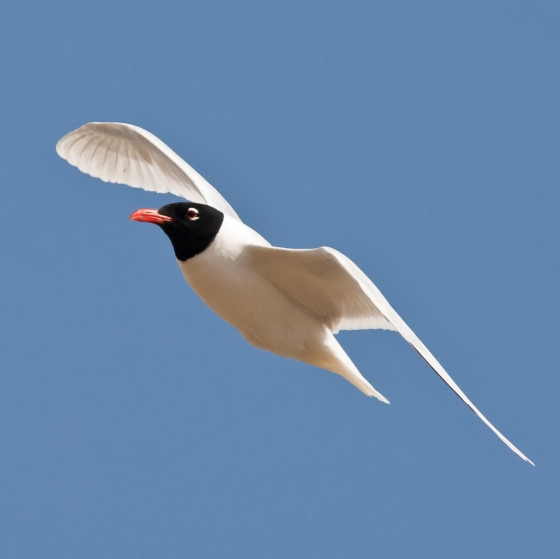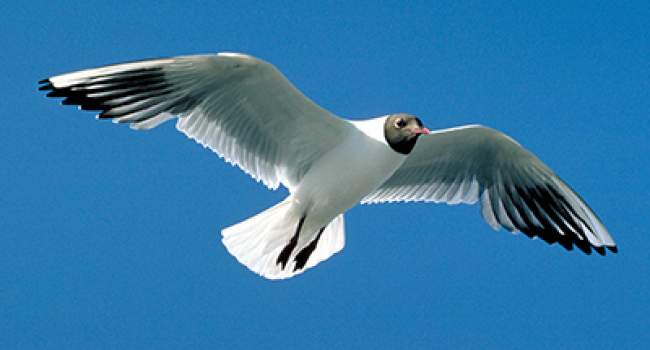Mediterranean Gull
Ichthyaetus melanocephalus (Temminck, 1820)
MU
 MEDGU
MEDGU  5750
5750

Family: Charadriiformes > Laridae

The white-winged Mediterranean Gull is very much a bird of our southern and eastern coasts, where it frequents saltmarsh and beach.
The Mediterranean Gull is actually quite scarce around the Mediterranean coast; its name is a misnomer, as the main breeding area for this beautiful gull is to be found around the Black Sea. The first pair of Mediterranean Gulls bred in the UK in 1968 and the species colonised Ireland from the mid-1990s; since then numbers have increased.
Mediterranean Gulls can be seen here throughout the year, ranging more widely during the winter months when individuals may be encountered all around our coast.
Identification
Mediterranean Gull identification is often straightforward. The following article may help when identifying Mediterranean Gull.
Identifying small black-headed gulls

A hooded gull in summer is likely to be the ubiquitous Black-headed Gull, but there are a couple of other species that sport the same summer finery. Would you be able to pick out a Little or Mediterranean Gull from the crowd?
SONGS AND CALLS
Listen to example recordings of the main vocalisations of Mediterranean Gull, provided by xeno-canto contributors.
Call
Develop your bird ID skills with our training courses
Our interactive online courses are a great way to develop your bird identification skills, whether you're new to the hobby or a competent birder looking to hone your abilities.
Browse training coursesStatus and Trends
Population size and trends and patterns of distribution based on BTO surveys and atlases with data collected by BTO volunteers.
CONSERVATION STATUS
This species can be found on the following statutory and conservation listings and schedules.
POPULATION CHANGE
This species was first recorded as a UK breeding species in Hampshire in 1968 (Taverner 1970). Since then it has expanded its range and now breeds in all four countries of the UK and its population has increased substantially. Numbers reported to the RBBP peaked at 2,400 pairs in 2018 but dropped to c.1,200 pairs in 2019, due mostly to a large reduction at one colony in Hampshire (Eaton et al. 2021).
DISTRIBUTION
Mediterranean Gulls first bred in Britain in 1968 and have bred annually since the late 1970s. Breeding in Britain is concentrated along the south and east coasts between Dorset and Norfolk but the expansion to inland sites in Britain, where they breed amongst Black-headed Gulls, is one of the most striking changes since the 1988–91 Breeding Atlas. The population is still increasing and spreading northwards. In winter, Mediterranean Gulls have a largely coastal distribution, though careful scanning through flocks of Black-headed Gulls at inland gull roosts and refuse tips probably accounts for the band of occupied squares from northwest England, through the midlands to London and the southeast.
Occupied 10-km squares in UK
| No. occupied in breeding season | 96 |
| % occupied in breeding season | 3.2 |
| No. occupied in winter | 706 |
| % occupied in winter | 23 |
European Distribution Map
DISTRIBUTION CHANGE
Change in occupied 10-km squares in the UK
| % change in range in breeding season (1968–72 to 2008–11) | +7100% |
| % change in range in winter (1981–84 to 2007–11) | +367.1% |
SEASONALITY
Mediterranean Gulls can be recorded throughout the year, although there is a post-breeding influx from July onwards.

Movement
Information about movement and migration based on online bird portals (e.g. BirdTrack), Ringing schemes and tracking studies.
RINGING RECOVERIES
View a summary of recoveries in the Online Ringing Report.
Foreign locations of birds ringed or recovered in Britain & Ireland

Biology
Lifecycle and body size information about Mediterranean Gull, including statistics on nesting, eggs and lifespan based on BTO ringing and nest recording data.
SURVIVAL & LONGEVITY
View number ringed each year in the Online Ringing Report
Maximum Age from Ringing 
|
18 years 2 months 28 days (set in 2009) 
|
CODES & CLASSIFICATION
Ring size 
|
E |
Field Codes 
|
2-letter: MU | 5-letter code: MEDGU | Euring: 5750 |
For information in another language (where available) click on a linked name
Research
Interpretation and scientific publications about Mediterranean Gull from BTO scientists.
CAUSES AND SOLUTIONS
Causes of change
The Mediterranean Gull expanded its range across Europe during the 20th century and this expansion has continued across the UK. The precise reasons for its success are unclear.
Links to more studies from ConservationEvidence.com
Would you like to search for another species?












Share this page